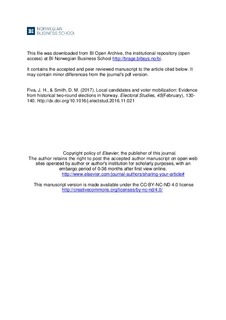| dc.contributor.author | Fiva, Jon H. | |
| dc.contributor.author | Smith, Daniel M. | |
| dc.date.accessioned | 2017-04-19T09:00:33Z | |
| dc.date.available | 2017-04-19T09:00:33Z | |
| dc.date.issued | 2017 | |
| dc.identifier.citation | Electoral Studies, 45(2017)February, 130-140 | nb_NO |
| dc.identifier.issn | 0261-3794 | |
| dc.identifier.issn | 1873-6890 | |
| dc.identifier.uri | http://hdl.handle.net/11250/2437708 | |
| dc.description | The accepted and peer reviewed manuscript | nb_NO |
| dc.description.abstract | What effect do candidates with local ties have on voter turnout and party support? A considerable challenge within the existing literature on the personal vote, including that part which derives from local ties, is disentangling it from the party vote using observational data. We exploit the unique institutional context of Norway’s historical two-round system, and data measured at the municipality level, to evaluate the mobilizational impact of voter attachment to parties versus (local) candidates. Under this system, entry into the second round was unrestricted, with the number and identity of candidates determined by elite coordination decisions. In municipalities where coordination at the district level between rounds resulted in the withdrawal of a candidate with local ties, we document a strong negative effect on both turnout and party support, which highlights the value of the personal vote for mobilization, and the potential trade-offs that confront parties and coalitions in nomination decisions. | nb_NO |
| dc.language.iso | eng | nb_NO |
| dc.publisher | Elsevier | nb_NO |
| dc.title | Local candidates and voter mobilization: Evidence from historical two-round elections in Norway | nb_NO |
| dc.type | Journal article | nb_NO |
| dc.type | Peer reviewed | nb_NO |
| dc.source.journal | Electoral Studies | nb_NO |
| dc.identifier.doi | http://dx.doi.org/10.1016/j.electstud.2016.11.021 | |
| dc.description.localcode | 2. Forfatterversjon | nb_NO |
